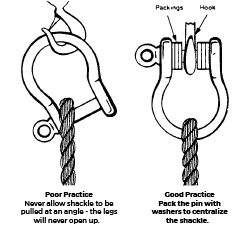Fibre rope is a commonly used tool which has many applications in hoisting and rigging operations. These ropes are readily available in a wide variety of synthetic and natural fibre materials and may be used as:
- Slings for hoisting materials
- Hand-lines for lifting light loads
- Taglines to guide and control loads
There are numerous situations where the rigger will be required to tie a safe and reliable knot or hitch in a fibre rope as part of the rigging operation. Fastening a hook, making eyes for slings, and tying on a tagline are a few of these situations.
Fibre Ropes
Fibre ropes are composed of either natural or synthetic fibres.
- Natural fibre ropes should be used cautiously for rigging since their strength is more variable than that of synthetic fibre ropes and they are much more subject to deterioration from rot, mildew, and chemicals.
- Polypropylene is the most common fibre rope used in rigging. It floats but does not absorb water. It stretches less than other synthetic fibres such as nylon. It is affected, however, by the ultraviolet rays in sunlight and should not be left outside for long periods. It also softens with heat and is not recommended for work involving exposure to high heat.
- Nylon fibre is remarkable for its strength. A nylon rope is considerably stronger than the same size and construction of polypropylene rope. But nylon stretches and hence is not used much for rigging. It is also more expensive, loses strength when wet, and has low resistance to acids.
- Polyester ropes are stronger than polypropylene but not as strong as nylon. They have good resistance to acids, alkalis, and abrasion; do not stretch as much as nylon; resist degradation from ultraviolet rays; and don’t soften in heat.
All fibre ropes conduct electricity when wet. When dry, however, polypropylene and polyester have much better insulating properties than nylon.
Rope Care and Inspection
- Inspect fibre rope regularly and before each use. Any estimate of its capacity should be based on the portion of rope showing the most deterioration.
- Check first for external wear and cuts, variations in size and shape of the strands, discolouration, and the elasticity or “life” remaining in the rope.
- Untwist the strands without kinking or distorting them. The inside of the rope should be as bright and clean as when it was new. Check for broken yarns, excessively loose strands and yarns or an accumulation of powdery dust, which indicates excessive internal wear between strands as the rope is flexed back and forth in use.
- If the inside of the rope is dirty, if the strands have started to unlay, or if the rope has lost life and elasticity, do not use it for hoisting.
- Check for distortion in hardware. If thimbles are loose in the eyes. Seize the eye to tighten the thimble. Ensure that all splices are in good condition and all tucks are done up.
Rope Care and Storage
- To unwind a new coil of fibre rope, lay it flat with the inside end closest to the loop. Pull the inside end up through the coil and unwind counter
- After use, recoil the rope Keep looping the rope over your left arm until only about 4.5 m (15 ft) remain. Start about 300 mm (12 in) from the top of the coil and wrap the rope about six times around the loops. Then use your left hand to pull the bight back through the loops and tie with a couple of half-hitches to keep the loops from uncoiling.

- Remove kinks Never try to pull them straight as this will severely damage the rope and reduce its strength.
- When a fibre rope is cut, the ends must be bound or whipped to keep the strands from untwisting.
- Store fibre ropes in a dry cool room with good air circulation-temperature 10-21°C (50- 70°F) and relative humidity 40-60%.
- Hang fibre ropes in loose coils on large diameter wooden pegs well above the
- Protect fibre ropes from weather, dampness, and sunlight. Keep them away from exhaust gases, chemical fumes, boilers, radiators, steam pipes, and other heat
- Let fibre ropes dry before storing Moisture hastens rot and causes rope to kink easily. Let a frozen rope thaw completely before you handle it, otherwise fibres can break. Let wet or frozen rope dry naturally. Wash dirty ropes in clean cool water and hang to dry.
Rope Use
- Never overload a rope. Apply the safety factor of 5 when using to hoist equipment (10 for ropes used to support or hoist personnel). Then make further allowances for the rope’s age and condition.
- Never drag a rope along the Abrasive action will wear, cut, and fill the outside surfaces with grit.
- Never drag a rope over rough or sharp edges or across Use softeners to protect rope at the sharp corners and edges of a load.
- Avoid all but straight line pulls with fibre rope. Bends interfere with stress distribution in
- Always use thimbles in rope Thimbles cut down on wear and stress.
- Keep sling angles at more than 45°. Lower angles can dramatically increase the load on each leg. The same is true with wire rope slings.
- Never use fibre rope near welding or flame cutting. Sparks and molten metal can cut through the rope or set it on fire.
- Keep fibre rope away from high heat. Don’t leave it unnecessarily exposed to strong sunlight, which weakens and degrades the rope.
- Never couple left-lay rope to right-lay.
- When coupling wire and fibre ropes, always use metal thimbles in both eyes to keep the wire rope from cutting the fibre rope.
- Make sure that fibre rope used with tackle is the right size for the sheaves. Sheaves should have diameters at least six-preferably ten-times greater than the rope diameter.
Knots and Hitches
Wherever practical, avoid tying knots in rope. Knots, bends and hitches will reduce rope strength considerably. Use a spliced end with a hook or other standard rigging hardware such as slings and shackles to attach ropes to loads.
In some cases, however, knots are more practical and efficient than other rigging methods, such as for lifting and lowering tools or light materials.
For knot tying, a rope is considered to have three parts:
- The end is where you tie the knot.
- The standing part is inactive.
- The bight is in between.
 Following the correct sequence is essential in tying knots. Equally important is the direction the end is to take and whether it goes over, under, or around other parts of the rope. There are overhand loops, underhand loops, and turns.
Following the correct sequence is essential in tying knots. Equally important is the direction the end is to take and whether it goes over, under, or around other parts of the rope. There are overhand loops, underhand loops, and turns.
WARNING – When tying knots, always follow the directions over and under precisely. If one part of the rope must go under another, do it that way, otherwise an entirely different knot – or no knot at all – will result.
Once knots are tied, they should be drawn up slowly and carefully to make sure that sections tighten evenly and stay in proper position.
Types of Knots
- Bowline
Never jams or slips when properly tied. A universal knot if properly tied and untied. Two interlocking bowlines can be used to join two ropes together. Single bowlines can be used for hoisting or hitching directly around a ring. - Bowline on the Bight
Used to tie a bowline in the middle of a line or to make a set of double-leg spreaders for lifting pipe. Can also be used as a sling. Sit in one loop and put the other around the back and under the arms.
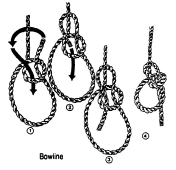
- Reef or Square Knot
Can be used for tying two ropes of the same diameter together. It is unsuitable for wet or slippery ropes and should be used with caution since it unties easily when either free end is jerked. Both live and dead ends of the rope must come out of the loops at the same side.
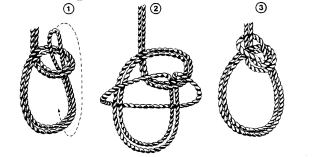
- Two Half Hitches
Can be quickly tied, are reliable and can be put to almost any general use.

- Running Bowline
Mainly used for the knot to grip.- Make an overhand loop with the end of the rope held toward you.
- Hold the loop with your thumb and fingers and bring the standing part of the rope back so that it lies behind the loop.
- Take the end of the rope in behind the standing part, bring it up, and feed it through the loop.
- Pass it behind the standing part at the top of the loop and bring it back down through the loop
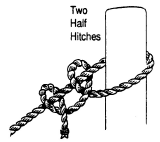
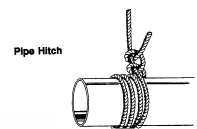
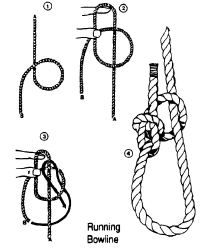 Figure-Eight Knot
Figure-Eight Knot
This knot is generally tied at the end of a rope to temporarily prevent the strands from unlaying. The figure-eight knot can be tied simply and quickly and will not jam as easily as the overhand knot. It is also larger, stronger, and does not injure the rope fibres. The figure-eight knot is useful in preventing the end of a rope from slipping through a block or an eye.
1.8.2.1 Wire Ropes, Slings, and Hardware
The rigger must be able to rig the load to ensure its stability when lifted and requires knowledge of safe sling configurations and the use of related hardware including shackles, eyebolts and wire rope clips.

Determining the working load limits of the rigging equipment as well as the weight of the load is a fundamental requirement of safe rigging practice.
The working load limits of all hoisting equipment and rigging hardware are based on almost ideal conditions that are seldom achieved in the field. Therefore, it is important to recognize the factors such as wear, improper sling angles, point loading, and center of gravity that can affect the rated working load limit of equipment and hardware.
This section describes the selection and safe use of various types of slings, and different kinds of rigging hardware.
Wire Rope
Proper rope selection will protect workers, property and the public from harm. An experience rigger will be familiar with hoisting hazards and will have knowledge to select the most appropriate rope for a specific load. A proper selected rope will:
- Withstand repeated bending without any failure of the wire strands
- Resist abrasion
- Withstand any distortion or crushing
- Resist rotation
- Resist corrosion
Slings
Slings are often severely worn and abused in construction. Damage is caused by:
- Failure to provide blocking or softeners between slings and load, thereby allowing sharp edges or corners of the load to cut or abrade the slings.
- Pulling them out from under loads, leading to abrasion and kinking.
- Shock loading increases the stress on slings that may already be overloaded
- Traffic running over slings, especially tracked equipment.
Because of these and other conditions, as well as errors in calculating loads and estimating sling angles, it is strongly recommended that safe working loads be based on a safety factor of at least 5:1.
For the same reasons, slings must be carefully inspected before each use.
Slings are not only made of various materials such as wire rope and nylon web. They also come in various configurations for different purposes.
Fibre Rope Slings
Fibre rope slings are preferred for some applications because they are pliant, grip the load well and do not mar its surface. They should be used only on light loads and must never be used on objects that have sharp edges capable of cutting the rope or in applications where the sling will be exposed to high temperatures, severe abrasion or acids.
The choice of rope type and size will depend on the application, the weight to be lifted and the sling angle. Before lifting any load with a fibre rope sling, be sure to inspect the sling carefully. Fibre slings, especially manila, deteriorate far more rapidly than wire rope slings and their actual strength is very difficult to estimate.
Like other slings, fibre rope slings should be inspected regularly. Look for external wear and cutting, internal wear between strands, and deterioration of fibres. Open up the rope by untwisting the strands but take care not to kink them. The inside of the rope should be as bright and clean as when it was new. Check for broken or loose yarns and strands. An accumulation of powder-like dust indicates excessive internal wear between strands as the rope is flexed back and forth during use.
1.8.2.2 Rigging Hardware
Know what hardware to use, how to use it, and how its working load limits (WLL) compare with the rope or chain used with it. All fittings must be of adequate strength for the application. Only forged alloy steel load-rated hardware should be used for overhead lifting. Load rated hardware is stamped with its WLL.
Inspect hardware regularly and before each lift. Check for obvious damage, cracks and twisting including:
- Wear
- Cracks
- Severe corrosion
- Deformation/bends
- Mismatched parts
Hoisting Hooks
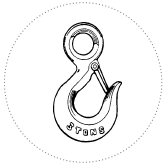
- Should be equipped with safety catches (except for sorting or grab hooks).
- Should be forged alloy steel with WLL stamped or marked on the saddle.
- Should be loaded at the middle of the hook. Applying the load to the tip will load the hook eccentrically and reduce the safe working load considerably.
- Should be inspected regularly and often. Look for wear, cracks, corrosion, and twisting, especially at the tip, and check throat for signs of opening up.
Wire Rope Clips
 Wire rope clips are widely used for making end terminations. are available in two basic designs: U-bolt and fist grip.
Wire rope clips are widely used for making end terminations. are available in two basic designs: U-bolt and fist grip.
When using U-bolt clips, make sure you have the right type of clip. Forged alloy clips are recommended. Always make certain that U-bolt clips are attached correctly. The U-section must be in contact with the dead end of the rope. Tighten and retighten nuts as required by the manufacturer.
Whenever two or more ropes are to be placed over a hook, use a shackle to reduce wear and tear on thimble eyes.
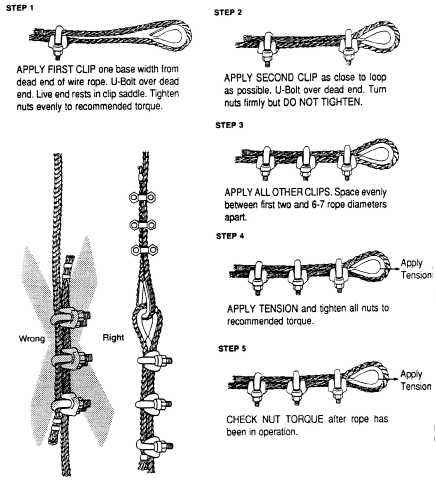
Swivels
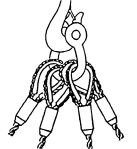
Swivels reduce bending loads on rigging attachments by allowing the load to orient itself freely and should be used instead of shackles in situations where the shackle may twist.
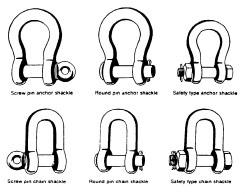
Shackles
Shackles are available in various types. For hoisting, they should be manufactured of forged alloy steel.
Do not replace shackle pins with bolts. Pins are designed and manufactured to match shackle capacity.
- Check for wear, distortion, and opening up. Check crown regularly for wear. Discard shackles noticeably worn at the crown.
- Do not use a shackle where it will be pulled or loaded at an angle. This severely reduces its capacity and opens up the leg.
- Do not use screw pin shackles if the pin can roll under load and unscrew.
